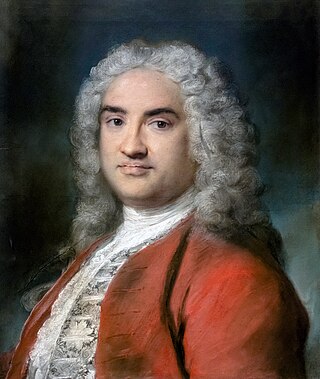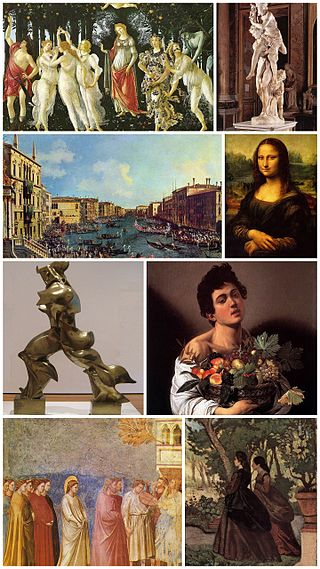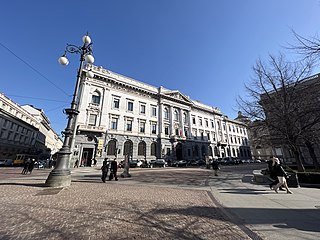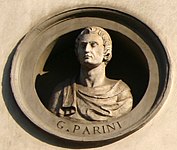
Cesare Cantù was an Italian historian, writer, archivist and politician. An immensely prolific writer, Cantù was one of Italy's best-known and most important Romantic scholars.

Count Pietro Verri was an Italian economist, historian, philosopher and writer. Among the most important personalities of the 18th-century Italian culture, he is considered among the fathers of the Lombard reformist Enlightenment and the most important pre-Smithian authority on cheapness and plenty.

Alessandro Verri was an Italian author.

The Palazzo delle Scuole Palatine is a historic building of Milan, Italy, located in Piazza Mercanti, the former city centre in the Middle Ages. It served as the seat of the most prestigious higher school of medieval Milan. Many notable Milanese scholars of different ages studied or taught in these schools; Augustine of Hippo and Cesare Beccaria, among others, served as teachers in the Palatine. The current building dates back to 1644, when it replaced an older one, which had the same function and was destroyed by a fire.

The Zone 1 of Milan, since 2016 officially Municipality 1 of Milan, is one of the 9 administrative divisions of Milan, Italy.

The 1700s refers to a period in Italian history and culture which occurred during the 18th century (1700–1799): the Settecento. The Settecento saw the transition from Late Baroque to Neoclassicism: great artists of this period include Vanvitelli, Canaletto and Canova, as well as the composer Vivaldi and the writer Goldoni.

The Gallerie d'Italia - Milano is a modern and contemporary museum in Milan, Italy. Located in Piazza della Scala in the Palazzo Brentani and the Palazzo Anguissola Antona Traversi, it hosts 195 artworks from the collections of Fondazione Cariplo with a strong representation of nineteenth century Lombard painters and sculptors, including Antonio Canova and Umberto Boccioni. A new section was opened in the Palazzo della Banca Commerciale Italiana on October 25, 2012 with 189 art works from the twentieth century.

The art collections of Fondazione Cariplo are a gallery of artworks with a significant historical and artistic value owned by Fondazione Cariplo in Italy. It consists of 767 paintings, 116 sculptures, 51 objects and furnishings dating from the first century AD to the second half of the twentieth.

Neoclassical architecture in Milan encompasses the main artistic movement from about 1750 to 1850 in this northern Italian city. From the final years of the reign of Maria Theresa of Austria, through the Napoleonic Kingdom of Italy and the European Restoration, Milan was in the forefront of a strong cultural and economic renaissance in which Neoclassicism was the dominant style, creating in Milan some of the most influential works in this style in Italy and across Europe. Notable developments include construction of the Teatro alla Scala, the restyled Royal Palace, and the Brera institutions including the Academy of Fine Arts, the Braidense Library and the Brera Astronomical Observatory. Neoclassicism also led to the development of monumental city gates, new squares and boulevards, as well as public gardens and private mansions. Latterly, two churches, San Tomaso in Terramara and San Carlo al Corso, were completed in Neoclassical style before the period came to an end in the late 1830s.

Giuseppe Zanoia (1752–1817) was an Italian Neoclassical architect who is remembered for his Porta Nuova in Milan. He also collaborated on the Neogothic design of Milan's Duomo.

The Palazzo Belgioioso is a palatial residence in the northern Italian city of Milan, completed in 1781 in a Neoclassical style by Giuseppe Piermarini.

The Palazzo Anguissola Antona Traversi is a palace located at Via Manzoni number 10, in central Milan, a city in the northern Italy. Construction began in 1778, and its Neoclassical facade, designed by Luigi Canonica, was added in 1829.

The Accademia dei Filodrammatici, is a drama school located in Milan, Italy and founded in 1796. It is the oldest theatre school in Italy.

The following outline is provided as an overview of and topical guide to Milan:

Palazzo Arese was a 16th century baroque palace and seat of a branch of the House of Arese in Milan, Italy. It was located adjacent to Casa Fontana Silvestri near the Porta Orientale. The palazzo was demolished in 1943 following damage sustained during the bombing of Milan in World War II.

The Accademia Nazionale Virgiliana di Scienze Lettere ed Arti is an Italian scientific institution.
Count Giuseppe Maria Imbonati was an aristocrat and patron of writers in Milan. He was one of the founders of the scholarly Accademia dei Trasformati.

The Enlightenment in Italy was a cultural and philosophical movement that began in the second half of the eighteenth century, characterized by the discussion of the epistemological, ethical, and political issues of the Enlightenment thought of the eighteenth century.

The monument to Leonardo da Vinci is a commemorative sculptural group placed in Milan's Piazza della Scala and unveiled in 1872. On the top is a statue of Leonardo da Vinci while the base depicts four of his pupils as full-length figures, Giovanni Antonio Boltraffio, Marco d'Oggiono, Cesare da Sesto, and Gian Giacomo Caprotti.


























